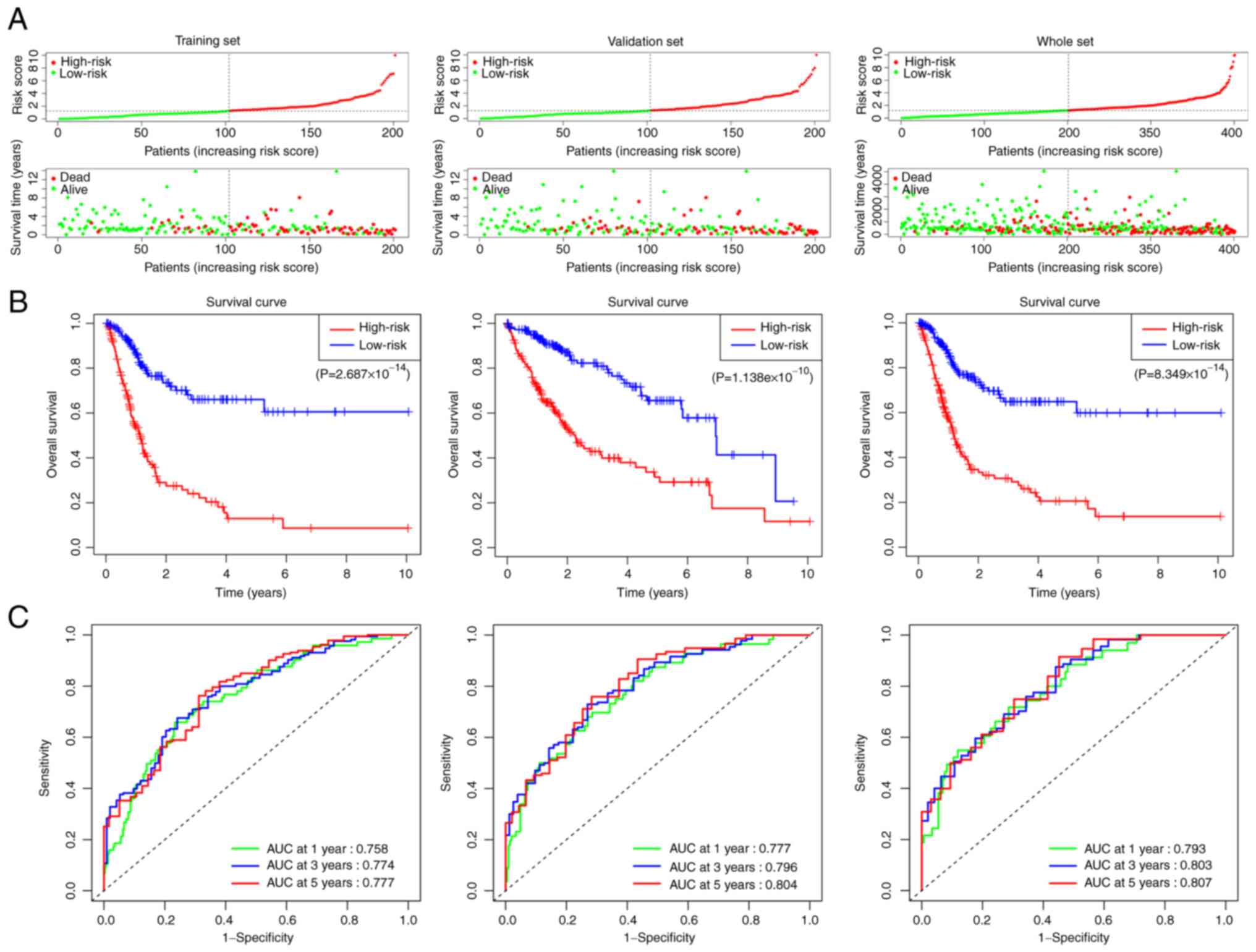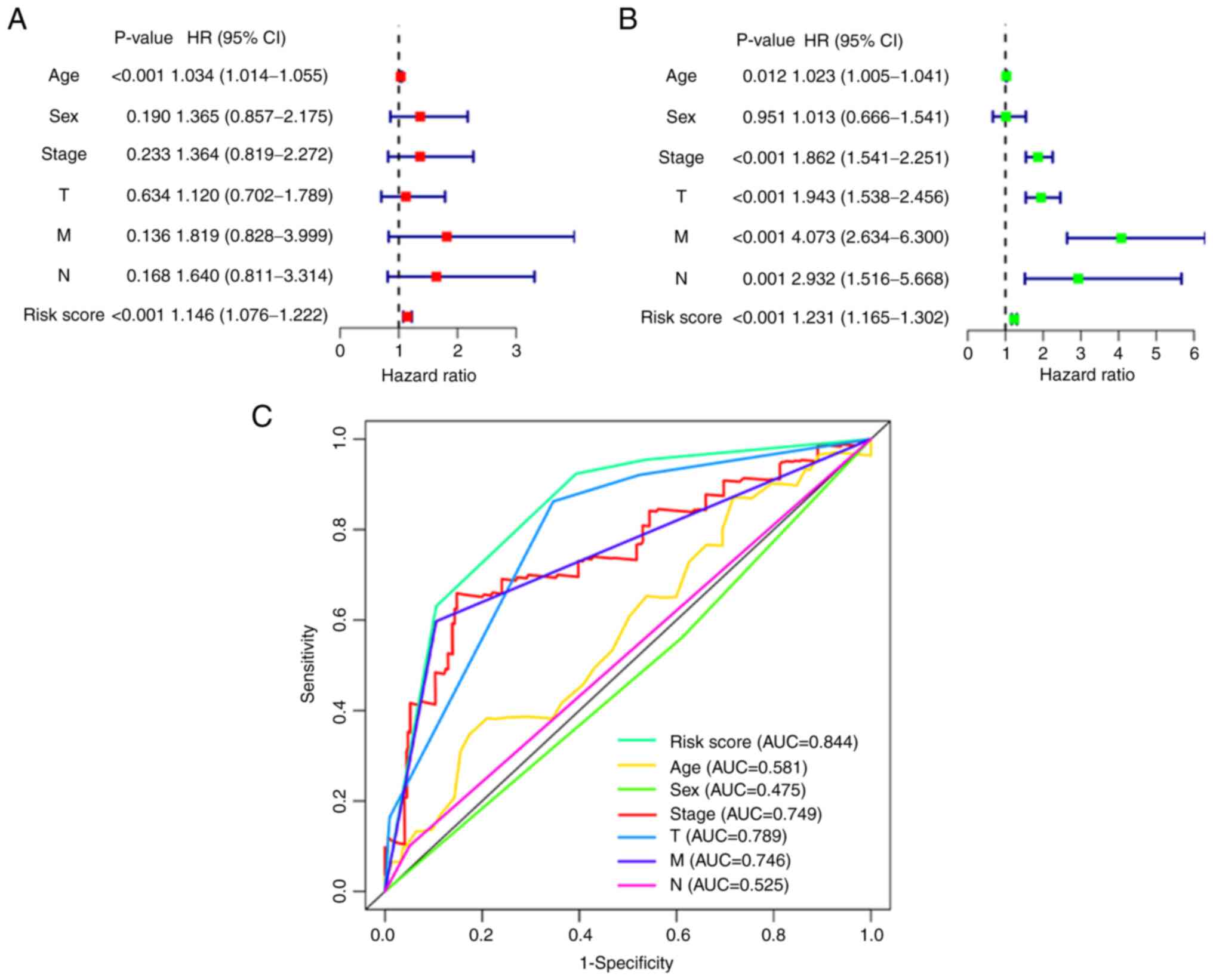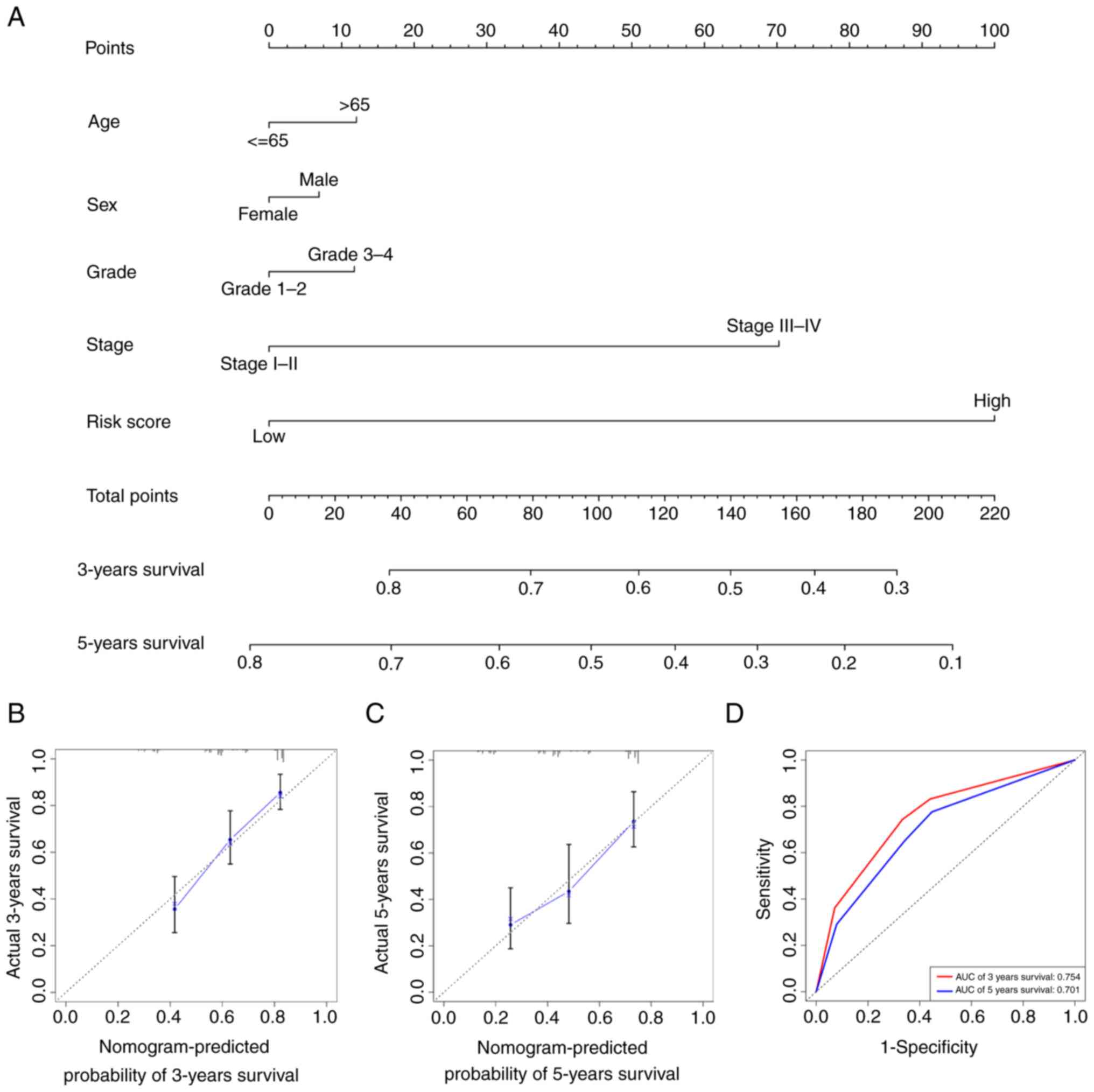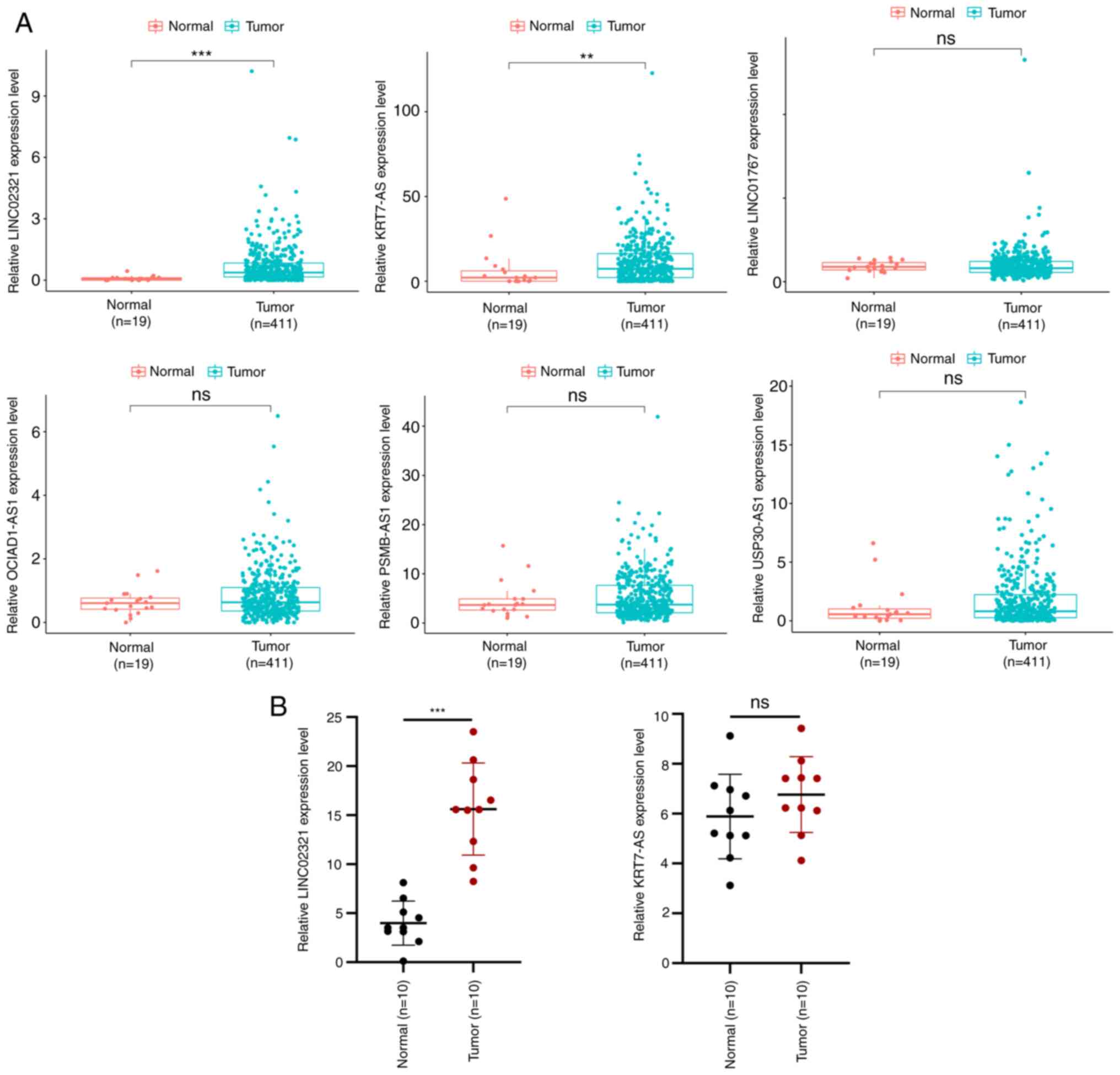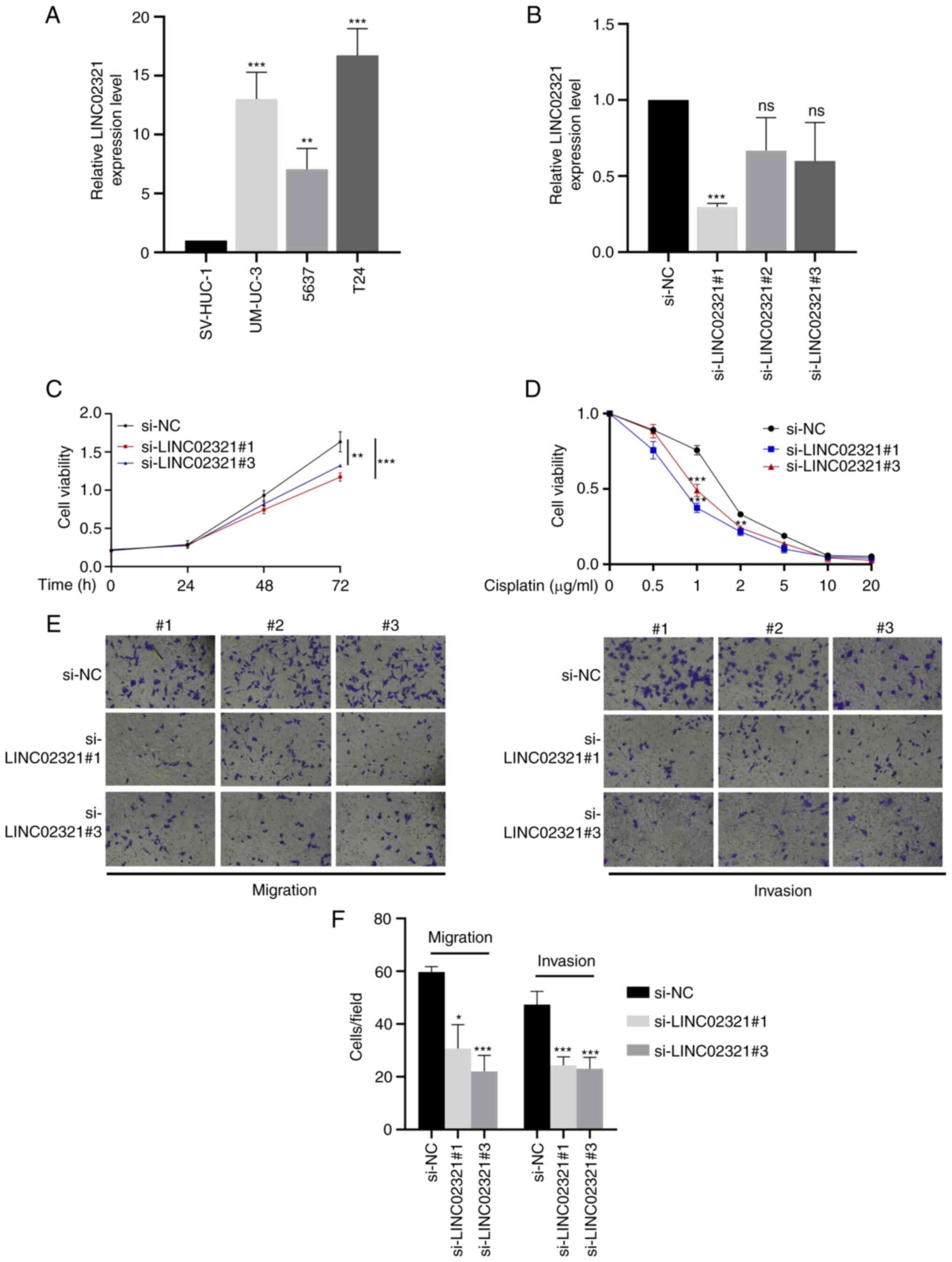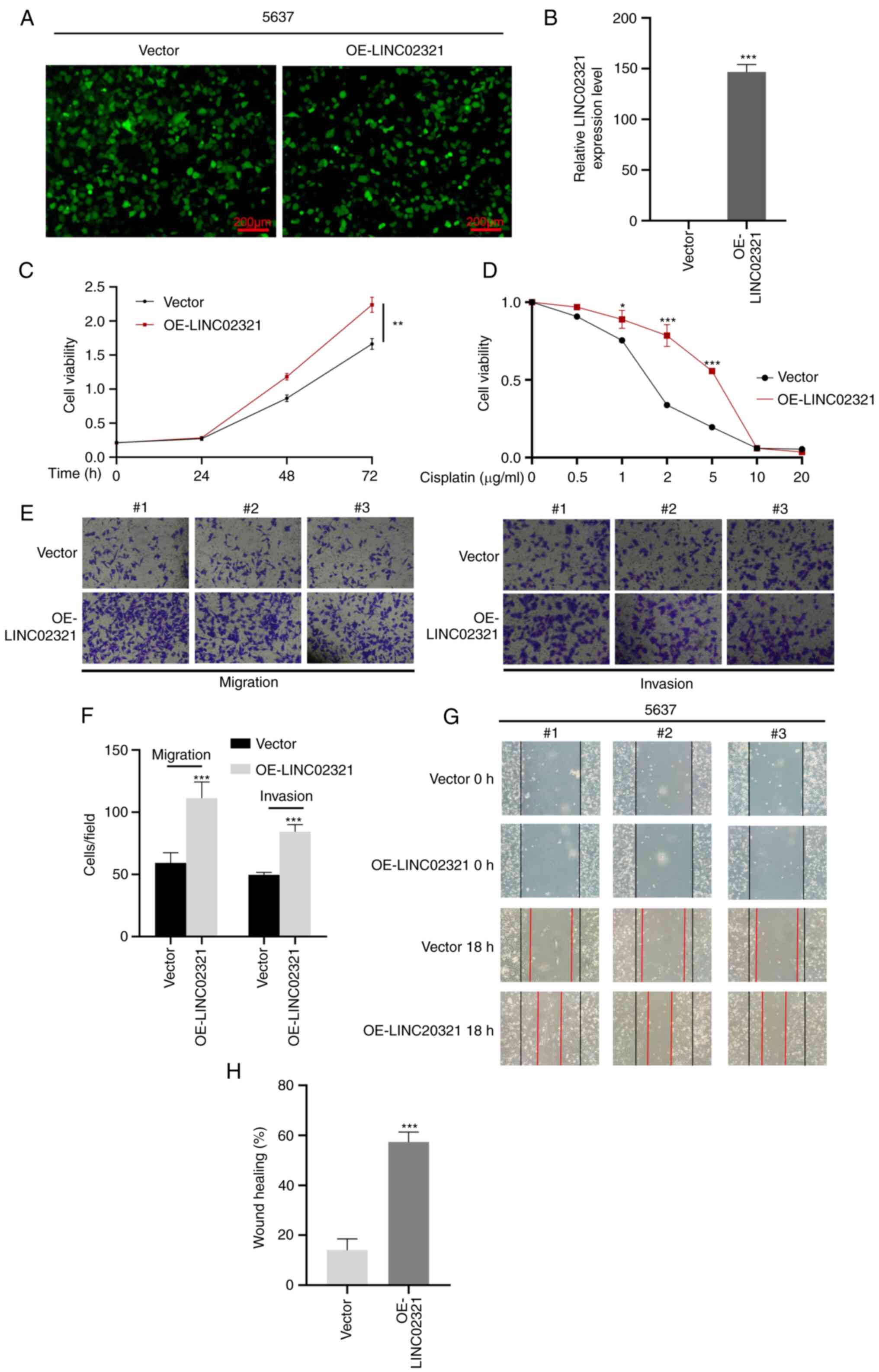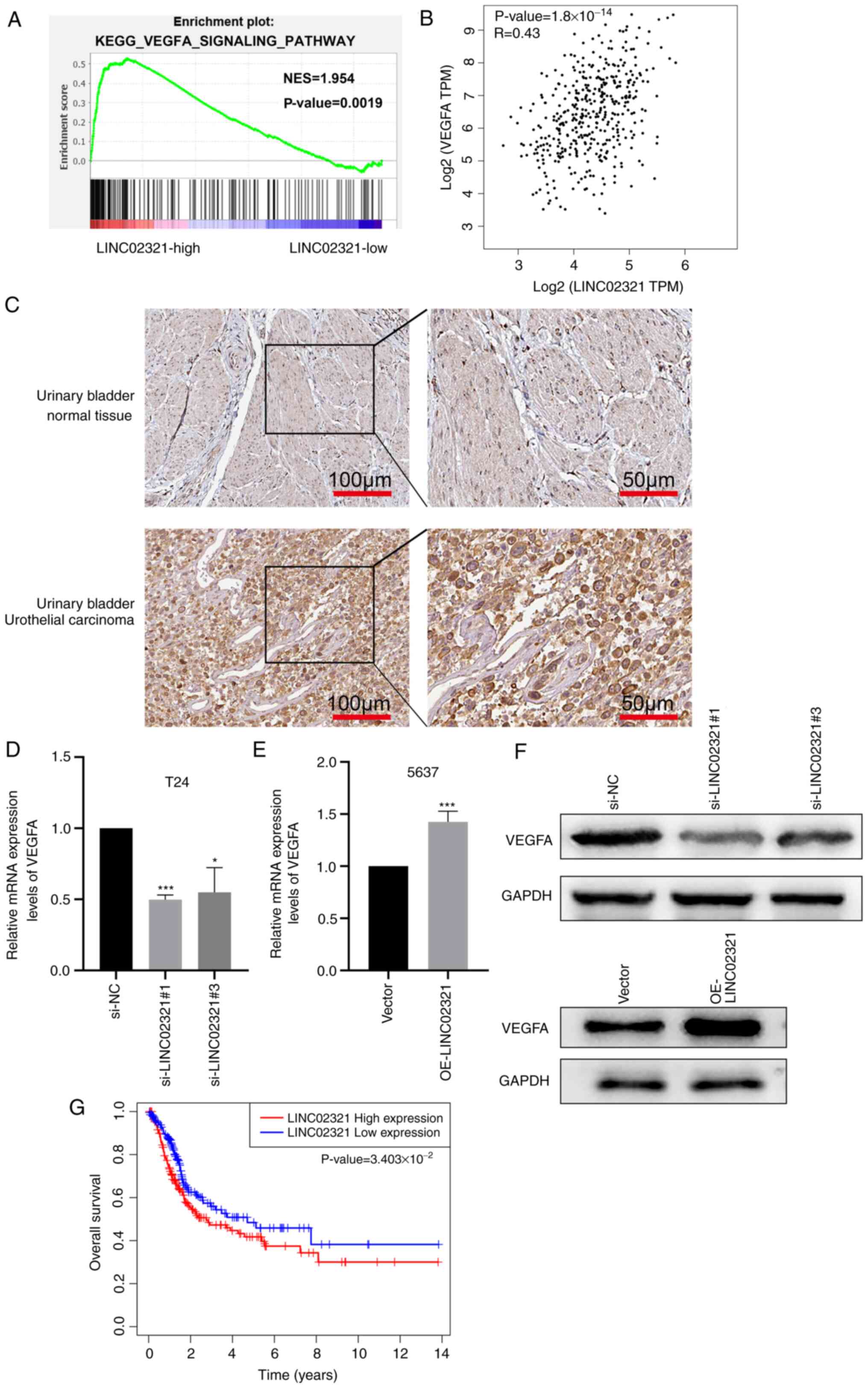An angiogenesis‑related lncRNA signature for the prognostic prediction of patients with bladder cancer and LINC02321 promotes bladder cancer progression via the VEGFA signaling pathway
- Authors:
- Published online on: December 29, 2022 https://doi.org/10.3892/mmr.2022.12925
- Article Number: 38
-
Copyright: © Kang et al. This is an open access article distributed under the terms of Creative Commons Attribution License.
Abstract
Introduction
Bladder cancer is one of the most common malignant tumours of the genitourinary system, the annual incidence of which is increasing worldwide, with ~550,000 new cases annually (1,2). Radical cystectomy is the primary treatment method for bladder cancer. However, ~50% of patients experience recurrence and cancer metastasis. Therefore, the 5-year survival rate of patients has not notably improved (3,4). The metastasis of bladder cancer is one of the primary factors that leads to the poor prognosis of patients. Previous studies have reported that the mechanism underlying bladder cancer metastasis is associated with tumour angiogenesis (5–7). Angiogenesis is the generation of microvessels on existing blood vessels and serves an important role in tumour metastasis (8).
In the human genome, <2% of the DNA sequence encodes proteins and the remaining sequences that do not encode proteins are known as non-coding sequences. Compared with simpler eukaryotes, the proportion of non-coding sequences is higher in the genome of more complex lifeforms (9,10). Long non-coding (lnc)RNAs belong to a class of non-protein-coding transcripts that are >200 base pairs in length and regulate gene expression on multiple levels. This can occur by modulation of chromatin modification, RNA splicing and protein activity, which influence the occurrence and progression of bladder cancer (11).
LncRNAs and angiogenesis serve important roles in the regulation of the progression of tumours. Therefore, in the present study, angiogenesis-associated lncRNAs were screened using The Cancer Genome Atlas (TCGA) database and the angiogenesis gene set from The Molecular Signatures Database. Using these data, an angiogenesis-associated lncRNA signature was constructed to predict the prognosis of patients with bladder cancer. Furthermore, the role and underlying mechanism of the angiogenesis-associated long intergenic non-coding RNA (LINC)02321 in the progression of bladder cancer was evaluated. The present study provided a new idea for the understanding of the mechanism of bladder cancer malignant progression and a new potential target for the treatment of bladder cancer patients.
Materials and methods
Data acquisition
Bladder cancer RNA-sequencing and clinical data (Table SI) were downloaded from TCGA database (https://portal.gdc.cancer.gov/. TCGA-BLCA). Bladder cancer cases were randomly divided into a training set (n=201) and a validation set (n=201) using a simple random grouping method. The signature was constructed with the training set and verified with the validation set and the whole set (n=402). A set of angiogenesis-associated genes (Table SII) were downloaded from the gene set ‘Angiogenesis, M14493’ in The Molecular Signatures Database (www.broadinstitute.org/gsea/msigdb).
Construction of the angiogenesis-associated lncRNA prognostic signature
The lncRNA expression data in bladder cancer from TCGA database were assessed using scripts written using the ‘Perl’ (version 5.32.1.1) programming language (https://www.perl.org/). Angiogenesis-associated lncRNAs were identified using Pearson's correlation analysis (BiocManager and limma packages; R software, version 4.0.2, http://cran.r-project.org/mirrors.html) (coefficient |R2|>0.5 and P<0.05). A total of 390 angiogenesis-associated lncRNAs were screened (Table SIII). Univariate/multivariate Cox regression analysis (survival package; R software, version 4.0.2) was performed to identify the patient prognosis-associated lncRNAs (Table SIV). A total of six angiogenesis-associated lncRNAs were identified as candidates for use in the prognostic signature (Table I). Cox regression analysis was used to analyze the relationship between the expression of lncRNAs and the survival and prognosis of patients with bladder cancer. Only the lncRNAs related to the prognosis of bladder cancer patients were screened. The six lncRNAs screened were closely related to the prognosis of bladder cancer patients).
Table I.Angiogenesis-associated lncRNAs significantly associated with the overall survival of patients with bladder cancer. |
Evaluation and verification of the accuracy of the prognostic signature
The risk score for each patient was calculated based on the following formula:
where ‘Coef(i)’ represents the estimated regression coefficient and ‘x(i)’ represents the expression of each angiogenesis-associated lncRNA. The patients with bladder cancer were categorised into low- and high-risk groups according to the median risk score (training set, 1.82462; validation set, 1.79457; whole set, 1.85822). The prediction efficiency of the angiogenesis-associated lncRNA signature was evaluated by plotting receiver operating characteristic (ROC) curves. The independent prediction ability of the signature was quantified using Cox regression analysis (survival package of R software, version 4.0.2).
Establishment of the nomogram and gene set enrichment analysis (GSEA)
We carried out COX regression analysis (rms package of R software, version 4.0.2) to construct nomogram. The nomogram was constructed by integrating clinical variables [age, sex, BLCA grade (12), American Joint Committee on Cancer (AJCC) stage (13)] and risk score to evaluate the overall survival (OS) of patients with bladder cancer. Calibration plots and time-dependent ROC curves were constructed to assess the nomogram. GSEA (4.0.3) was performed using the ‘c2.cp.kegg.v7.2.symbols.gmt’ Kyoto Encyclopaedia of Genes and Genomes gene sets (http://www.gsea-msigdb.org/gsea/index.jsp) to assess the LINC02321-associated pathways. Expression data for VEGFA in bladder cancer were obtained from the Human Protein Atlas database (www.proteinatlas.org; accession no. M-00100 and M812033).
Cell culture and tissue samples
The human bladder cancer cell lines 5637, T24 and UM-UC-3, and the ureteral epithelial cell line SV-HUC-1 were purchased from American Type Culture Collection. The bladder cancer cell lines were cultured in RPMI-1640 medium (Gibco; Thermo Fisher Scientific, Inc.) containing 10% FBS (PAN-Biotech GmbH) and 1% penicillin-streptomycin (Beyotime Institute of Biotechnology). SV-HUC-1 cells were cultured in DMEM (Corning, Inc.) containing 10% FBS and 1% penicillin-streptomycin. All cells were cultured in 5% CO2 at 37°C. Fresh bladder cancer and normal adjacent tissues (distance between tumor and adjacent tissue ≤3 cm) were collected from patients (n=10; age, 53–81 years; male, 8; female, 2) who underwent radical cystectomy at The First Affiliated Hospital of Chongqing Medical University between April 2021 and February 2022. Inclusion criteria used were as follows: i) Diagnosed with myometrial invasive bladder cancer or high-risk patients with non-muscular invasive bladder cancer who failed to respond to Bacillus Calmette-Guerin vaccine (BCG) therapy and underwent total cystectomy according to the 2020 European Urological Association Guidelines for Diagnosis and Treatment of Myometrial Invasive bladder cancer (14); ii) patients with basic language communication and understanding ability; iii) patients knew of their own conditions, were able to provide informed consent and volunteered to participate in the study. Patients with other malignant tumors involving other systems at the same time were excluded. Each patient signed a written informed consent form and the present study was approved by the Ethics Committee of the First Affiliated Hospital of Chongqing Medical University (approval no. 2021069; Chongqing, China).
Small interfering (si)RNA
All experiments using siRNA were performed in T24 cells. siRNA and negative control siRNA (si-NC) against LINC02321 were designed and synthesised by Shanghai Genepharma Co., Ltd. After the T24 cells reached 80% confluence, the medium was replaced with 1.5 ml basal medium containing 500 µl Lipofectamine® 2000 (Invitrogen, Thermo Fisher Scientific, Inc.) and 0.2 nmol siRNA, and the cells were incubated at 37°C for 6 h. The subsequent experiments related to lncRNA expression were performed 24 h later and the cell function experiments were performed 48 h later. The sequences of the siRNAs were as follows: si-LINC02321-#1, 5′-UUAUUCUGAATUATTUGUCAUUAUUCUCAAUGAGTTGAACAC-3′; si-LINC02321-#2, 5′-UATTCCUCUGAGGTTACUCACUAUUUAAAGUGAGUUAUUAAA-3′; si-LINC02321-#3, 5′-UUGGGAGTTUACAAAGAATTCUCCCUUCUAUCAGUGAGACUU-3′ and si-NC, 5′-UUCUCUCAACGUCGUTCCGAATGUGACGUGAAATCUCGGAGT-3′.
Construction of LINC02321-overexpressing cell lines
The lenti-vector and lenti-OE were cloned into the Gemma gene (Shanghai Jima Pharmaceutical Technology Co., Ltd.). The recombinant pGag/Pol-pRev-pVSV-G viral plasmid (3rd generation system) encoding lentivirus particles and the carrier plasmids of the three auxiliary packaging components were prepared and high-purity endotoxin free extraction was performed. 293T cells were co-transfected with 10 µg of the lentivirus (lentivirus, packaging, envelope plasmids=4:3:1) at 37°C using Shanghai Jima Pharmaceutical Technology Co., Ltd. company's transfection reagent RNAi Mate. Media was replaced with a complete medium 6 h after transfection. After 72 h of culture, the cell supernatant, was collected and concentrated to obtain a lentivirus concentrate with high titre for infection of target cells [multiplicity of infection (MOI)=30]. The infected target cells were screened using the resistance gene (Puromycin; 2 ng/ml for selection; 1 ng/ml for maintenance) and fluorescent fusion protein on the lentivirus vector. The plasmids, cell lines and other reagents were purchased from Shanghai Jima Pharmaceutical Technology Co., Ltd. The 5637 cells in a normal growth state were evenly seeded (using the cell count plate) into six-well plates and cultured in a 37°C incubator containing 5% CO2 when 5637 cells reached ~60% confluence. A basic RPMI-1640 medium (Gibco; Thermo Fisher Scientific, Inc.) containing the overexpressing lentivirus or control virus (MOI=30) was added to the culture for 24 h when the cells reached 30–50% confluency. After the virus was transfected into cells, puromycin (2 ng/ml) was added to the medium to screen and maintain the stably transfected cells for subsequent experiments. Subsequent experiments were carried out 24 h after successful screening. LINC02321 overexpression was compared with the empty vector control.
Reverse transcription-quantitative PCR (RT-qPCR)
RNA from cells (T24, 5637 and UM-UC-3 bladder cancer cell lines and the SV-HUC-1 ureteral epithelial cell line) and tissues (bladder cancer and normal adjacent tissues) was extracted using TRIzol® reagent (Invitrogen; Thermo Fisher Scientific, Inc.) according to the manufacturer's protocols. The extracted RNA was reverse-transcribed into cDNA using a Primescript RT kit (Takara Bio, Inc.) according to the manufacturer's protocol. qPCR (PCR kit, Takara Bio, Inc.) was performed using the following primer pairs (: LINC02321 forward (F), 5′-GGAGATGAGGACTGGGAGGT-3′ and reverse I, 5′-GGACAGCTGGGAAAGGAGTC-3′; and GAPDH F, 5′-GCAGCGAGATCCCTCCAAAAT-3′ and R, 5′-CTGTTGTCATACTTCTCATGG-3′, and thermocycling conditions of 95°C for 30 sec, followed by 40 cycles of 95°C for 5 sec and 65°C for 15 sec. The mRNA expression of GAPDH was used as the reference to calculate the expression level of the target gene. The 2-ΔΔCq method was used to calculate relative gene expression after normalization to GAPDH (15).
Wound healing assay
T24 cells were inoculated into a six-well plate and after reaching 100% confluency, a sterile pipette tip was used to scratch cells perpendicular to the plate (two lines horizontally and vertically) (16). Subsequently, serum-free RPMI-1640 medium (Gibco; Thermo Fisher Scientific, Inc.) was added before images were captured using an inverted light microscope. The time at which the images were captured was recorded as 0 h. Finally, serum-free RPMI-1640 medium (Gibco; Thermo Fisher Scientific, Inc.) was added and the cells were cultured at 37°C for 18 h. The migration of cells in the control and experimental groups was assessed at 18 h using an inverted light microscope (magnification, ×100). ImageJ software (National Institutes of Health, version 1.8.0) was used to assess the images.
Transwell experiments
Matrigel was used for invasion experiments and was placed in the upper layer of the Transwell chamber. Precoating was performed at 37°C for 4 h. A total of 8×104 T24 and 5637 cells were inoculated into each chamber and 600 µl RPMI-1640 medium with 10% FBS was added into the lower chamber for culture. The cells were incubated at 37°C for 12 h and fixed using 4% paraformaldehyde at 37°C for 15 min. The fixed cells were stained using 0.1% crystal violet solution at 37°C for 15 min. Following this, cells were imaged using a light microscope and quantified using ImageJ software (National Institutes of Health, version 1.8.0). The addition of Matrigel was not performed for Transwell migration experiments, but all subsequent procedures were identical to those aforementioned.
Cell counting kit-8 (CCK-8) proliferation assay
T24 and 5637 cells were inoculated into 96-well plates with 4,000 cells/well. A total of 10 µl CCK-8 reagent (Dojindo Molecular Technologies, Inc.) was added after 24, 48 and 72 h of incubation at 37°C for 1 h, before absorbance was assessed at 450 nm.
CCK-8 assay of cisplatin sensitivity
T24 and 5637 cells were inoculated into 96-well plates with 4,000 cells/well. After cells attached, cisplatin (Beijing Solarbio Science & Technology Co., Ltd.) was added at concentrations of 0.0, 0.5, 1.0, 2.0, 5.0, 10.0 and 20.0 µg/ml and cells were cultured at 37°C for 48 h. Subsequently, 10 µl CCK-8 reagent was added to each well and incubated for 1 h. Finally, the absorbance was assessed at 450 nm using a microplate reader.
Western blotting
RIPA buffer (Beyotime Institute of Biotechnology) containing PMSF (Beyotime Institute of Biotechnology) was used to extract cellular proteins. Protein concentration was assessed using a BCA protein analysis kit. Protein samples from each group (30 µg/lane) were separated using 10% SDS-PAGE and transferred onto PVDF membranes. PVDF membranes were blocked with QuickBlock™ Western rapid sealing solution (cat. no. P0252, Beyotime Institute of Biotechnology,) at room temperature for 30 min. Primary rabbit anti-VEGFA (1:1,000; cat. no. 50661; Cell Signaling Technology, Inc.) and anti-GAPDH (1:8,000; cat. no. 60004-1-Ig; ProteinTech Group, Inc.) antibodies were then added to the membranes, which were incubated at 4°C for ≥12 h. The membranes were incubated at 37°C for 1 h with HRP-labelled secondary antibody (1:3,000, cat. no. PR30011; ProteinTech Group, Inc; http://www.ptgcn.com/). Finally, a fusion imaging system QuantityOne (Bio-Rad Laboratories, Inc.) was used to assess the relative density of the band. ImageJ software (National Institutes of Health, version 1.8.0) was used for analysis.
Statistical analysis
Statistical analysis was performed using SPSS 20.0 software (IBM Corp.). Graphs were generated using GraphPad Prism 8.0 (GraphPad Software, Inc.). All data are presented as the mean ± standard deviation of experiments that were repeated three times. Paired Student's t test was used when comparing matched samples; unpaired Student's t test was used when comparing non-matched samples. Comparisons between multiple groups were performed using two-way ANOVA and post hoc Dunnett's test for multiple comparisons. The survival curves were produced and analysed using the Kaplan-Meier method and parallel log-rank inspection. P<0.05 was considered to indicate a statistically significant difference.
Results
Construction and verification of the angiogenesis-associated lncRNA signature
A total of 14,142 lncRNAs were identified using the ‘Perl’ programming language. A total of 390 angiogenesis-associated lncRNAs were screened using Pearson's correlation analysis (Table SIII). In the training set, 64 angiogenesis-associated lncRNAs were screened using univariate Cox regression analysis (Table SIV), of which six were identified as candidates for the prognostic signature using multivariate Cox regression analysis: USP30-AS1, LINC02321, PSMB8-AS1, KRT7-AS, LINC01767 and OCIAD1-AS1 (Table I). The patients in the training, validation and whole sets were divided into two groups according to the median risk score (Fig. 1A). The OS rate was significantly shorter in the high-risk group compared with that in the low-risk patients in each group (Fig. 1B). The sensitivity and specificity of the signature were evaluated based on the ROC. In the three sets, the highest area under the curve (AUC) value was 0.807 for the whole set at 5 years (Fig. 1C). These results demonstrated that the angiogenesis-associated lncRNA signature may accurately predict survival and prognosis of patients with bladder cancer.
Angiogenesis-associated lncRNA signature is an independent prognostic factor
The independent predictive ability of the risk score based on the angiogenesis-associated lncRNA signature and clinicopathological parameters on the prognosis of patients with bladder cancer was evaluated using Cox regression analysis. The results demonstrated a significant association between risk score of the signature and the OS time of patients (Fig. 2A and B). ROC curve results demonstrated that the AUC of the risk score, 0.844, was higher compared with those of the other clinicopathological parameters (Fig. 2C). These results suggested that the risk score based on the angiogenesis-associated lncRNA signature may be used as an independent factor to predict the prognosis of patients with bladder cancer.
Establishment of the nomogram
A nomogram combines multiple indicators to diagnose or predict the onset and progression of disease (17). Therefore, a nomogram was constructed based on the multivariate Cox regression analysis results by considering the risk score of the signature, age, sex, grade and AJCC stage of the tumour (Fig. 3A). Furthermore, calibration using Cox regression analysis (Fig. 3B) and ROC curves (Fig. 3C) were plotted to assess the predictive ability of the nomogram, which yielded 3-year and 5-year AUC values of 0.754 and 0.701, respectively (Fig. 3D).
LINC02321 is highly expressed in bladder cancer
Analysis of the angiogenesis-associated lncRNA signature was performed. The key lncRNAs of the signature were screened using prediction of their expression profiles from TCGA dataset and RT-qPCR validation of significant lncRNAs. In TCGA database, the expression profiles of the six lncRNAs in the signature were evaluated; only the expression levels of LINC02321 and KRT7-AS were significantly different when compared between the tumour and normal groups (Fig. 4A). Therefore, the expression levels of LINC02321 and KRT7-AS in tissues collected in the present study were evaluated by RT-qPCR. LINC02321 expression levels were significantly increased in bladder cancer tissue, whereas there was no statistically significant difference in the expression levels of KRT7-AS compared with the normal adjacent tissue (Fig. 4B). Therefore, LINC02321 was used as the target for subsequent experiments.
LINC02321 silencing in bladder cancer cells suppresses proliferation, migration and invasion, and enhances chemosensitivity to cisplatin
Expression of LINC02321 in bladder cancer cell lines was assessed using RT-qPCR. Compared with SV-HUC-1 normal uroepithelial immortalised cells, LINC02321 expression levels were significantly increased in the bladder cancer cell lines T24, 5637 and UM-UC-3, with T24 and 5637 demonstrating the highest and the lowest expression levels, respectively (Fig. 5A). Therefore, T24 was used for knockdown of LINC02321 expression, for which si-LINC02321#1 and si-LINC02321#3 were demonstrated to be the most efficient and were selected for subsequent use (Fig. 5B). CCK-8 proliferation assay results demonstrated that cell proliferation was significantly decreased after LINC02321 knockdown compared with si-NC (Fig. 5C). Furthermore, CCK-8 drug sensitivity assay demonstrated that the sensitivity of the cells to cisplatin (1.0 and 2.0 µg/ml) was increased significantly following LINC02321 knockdown compared with the si-NC (Fig. 5D). Transwell assays demonstrated that the invasive and migratory capability of the cells decreased significantly after LINC02321 knockdown compared with the si-NC (Fig. 5E and F).
LINC02321 overexpression in bladder cancer cells enhances proliferation, migration and invasion and suppresses chemosensitivity to cisplatin
LINC02321 was stably overexpressed in the 5637 bladder cancer cells following transfection with the lentiviral vector, which demonstrated high efficiency (Fig. 6A and B). CCK-8 proliferation assay demonstrated that cell proliferation increased significantly after LINC02321 overexpression compared with the empty vector control (Fig. 6C). CCK-8 drug sensitivity assay demonstrated that the sensitivity of the cells to 1, 2 and 5 µg/ml cisplatin decreased significantly after LINC02321 overexpression compared with the control (Fig. 6D). Transwell assays demonstrated that the invasive and migratory abilities of cells significantly increased after LINC02321 overexpression compared with the vector control (Fig. 6E and F). Since siRNA can affect the cell state, it is unsuitable for use in wound healing experiments. Therefore, wound healing assays were performed following LINC02321 overexpression, and the results demonstrated significantly increased wound healing rate following LINC02321 overexpression compared with the control (Fig. 6G and H).
VEGFA signaling is involved in LINC02321-regulated progression of bladder cancer
The downstream regulatory mechanism of LINC02321 was evaluated. GSEA demonstrated that the expression levels of LINC02321 in TCGA bladder cancer dataset was associated with the VEGFA signalling (Fig. 7A). Pearson's correlation analysis demonstrated that LINC02321 expression levels correlated positively with expression levels of VEGFA (Fig. 7B). Immunohistochemical staining images from the Human Protein Atlas database (www.proteinatlas.org) demonstrated that the intensity of VEGFA in bladder cancer tissues was markedly stronger compared with that in the adjacent mucosa (Fig. 7C). LINC02321 regulated mRNA and protein expression levels of VEGFA, which were assessed following transfection with si-LINC02321 and OE-LINC02321 using RT-qPCR (Fig. 7D and E) and western blotting (Fig. 7F), respectively. Furthermore, the association between LINC02321 expression and OS were analysed in 402 patients with bladder cancer from TCGA dataset. The survival time of patients with high LINC02321 expression levels was significantly shorter compared with that of patients with low expression levels (Fig. 7G). These results suggested that the VEGFA signalling pathway may be involved in LINC02321-regulated progression of bladder cancer and that LINC02321 may be a potential target for the treatment of this malignancy.
Discussion
Numerous biomarkers, including DNA methylation, templates with single-nucleotide polymorphisms, protein or metabolic changes and mRNA and non-coding RNA expression changes are associated with the occurrence of disease in the body (18). In clinical practice, tumour biomarkers are used to identify primary tumours and to screen high-risk populations, and they are key for the prognosis and prediction of the efficacy of treatments. Over the past decade, numerous bladder cancer-associated tumour markers, such as bladder tumour antigen series (19), nuclear matrix protein 22 (20) and fibrin degradation products (21), have been reported in clinical practice. These tumour markers facilitate the detection of occult bladder cancer in the clinic. To the best of our knowledge, however, there are currently no specific markers of malignancy that predict the survival and prognosis of patients with bladder cancer. Therefore, novel biomarkers associated with the prognosis of bladder cancer may have beneficial clinical applicability.
Bladder cancer metastasis of is one of the primary factors that leads to the poor prognosis of patients. Previous studies have reported that the mechanism of metastasis in bladder cancer is associated with tumour angiogenesis (5,22). Tumours become angiogenic through numerous methods, including outgrowth and sleeve-in angiogenesis, angiogenesis with the recruitment of endothelial progenitor cells and angiogenic mimicry (23–26). Vasculogenesis, which is associated with the recruitment of endothelial progenitor cells, is the main mechanism of tumour angiogenesis, alongside vascular sprouting. The initiation of neovascularisation requires activation of the angiogenic switch, followed by expression of matrix metalloproteinases to degrade the basement membrane (27). The endothelial cells proliferate after migration to the corresponding locations, where blood vessels are to be generated, under the action of chemokines and angiogenic factors produced by autocrine and paracrine mechanisms and develop into blood vessels with the support of tumour stromal cells (6). During this process, tumour and stromal cells interact to form a microenvironment suitable for angiogenesis. The main biological function of angiogenesis in malignant tumours is to enhance the ability of cells to metastasise (28). Investigation of the key components in angiogenesis and angiogenesis-driven processes in bladder cancer may enable evaluation of the malignant features of bladder cancer, such as invasion and metastasis, and the identification of novel therapeutic targets.
lncRNAs occupy a large proportion of the genomes of more complex forms of life and have been reported to serve a more important role than the sequences that encode proteins (9). lncRNAs regulate the expression of genes on multiple levels by regulation of chromatin modification, RNA splicing and protein activity, which regulate occurrence, development, prognosis and chemotherapy resistance of tumours (10). Previous studies have reported that lncRNAs can be used as novel biomarkers to predict occurrence, development and prognosis of bladder cancer. Higher expression levels of the serum exosome-derived lncRNA LNMAT2 have been reported to be associated with shorter survival time, which suggests that it may serve as a potential diagnostic biomarker and therapeutic target for lymph node metastasis in bladder cancer (29). Furthermore, normal bladder tissue-derived exosomes have been reported to inhibit malignant progression of bladder cancer through the lncRNA PTENP1, which may be used as a biomarker for the prediction of the survival of patients with bladder cancer (30). Another study reported that an angiogenesis-associated lncRNA signature based on data from TCGA database effectively predicted the prognosis of patients with bladder cancer, (31) which was similar to the results of the present study; therefore, these findings may provide a new perspective and novel antiangiogenic targets for clinical diagnosis and treatment strategies of bladder cancer. Furthermore, an epithelial-mesenchymal transition-associated 14-lncRNA signature was reported to effectively predict progression of bladder cancer and prognosis of patients (32). Another extracellular matrix-associated six-lncRNA signature was previously proposed to serve as a novel marker for the prediction of prognosis of patients with bladder cancer (33). With further study into the mechanism of lncRNAs that underlie tumorigenesis and development, the diagnostic performance of lncRNAs in progression and prognosis of bladder cancer will likely continue to improve.
Both lncRNAs and angiogenesis serve important roles in the prediction of the progression of bladder cancer. Therefore, in the present study, bioinformatics was used to analyse the predictive performance of an angiogenesis-associated lncRNA signature in the prognosis of bladder cancer, and six lncRNAs were identified to be significantly associated with OS of patients with bladder cancer. Therefore, a signature based on these six angiogenesis-associated lncRNAs was constructed. Patients were divided based on risk score of the signature, and the OS of patients in the low-risk group was significantly longer compared with that of patients in the high-risk group; this suggested that the six angiogenesis-associated lncRNA signature in the present study aided the prediction of the prognosis of patients with bladder cancer. A nomogram was constructed, and compared with the other clinical indicators, the risk score of the signature demonstrated markedly higher predictive power for patient prognosis.
From the six angiogenesis-associated lncRNA signature, RT-qPCR and TCGA data analysis demonstrated that LINC02321 expression levels differed significantly between bladder cancer and normal tissue. It was subsequently demonstrated that LINC02321 expression correlated positively with that of VEGFA, a key member of the VEGF family (34). VEGFA has been reported to serve an important role in the promotion of tumour progression (34). It has been reported that certain lncRNAs promote tumour progression through regulation of VEGFA. For example, lncRNA PVT1 was previously reported to promote gastric cancer progression by activation of the STAT3/VEGFA axis (35). Furthermore, lncRNA TUSC8 has been reported to affect proliferation and migration of oesophageal cancer cells through the regulation of VEGFA (36). In another study, LINC00707 was reported to regulate the VEGFA pathway to enhance the progression of cervical cancer (37). The lncRNA SNHG16 has been reported to drive the proliferation, migration and invasion of lung cancer cells by modulating of the VEGF axis (38). In the present study, it was demonstrated that LINC02321 positively regulated VEGFA mRNA and protein expression levels. Previous studies have reported that VEGFA directly promotes malignant progression of bladder cancer (39,40). Therefore, based on results from the present study and those of previous studies, it was hypothesised that LINC02321 promotes the malignant progression of bladder cancer via the VEGFA signalling pathway. Finally, the prognostic role of LINC02321 in patients with bladder cancer was analysed. The prognosis of patients with high LINC02321 expression levels was significantly poorer compared with those of patients with low LINC02321 expression levels. These results suggested that LINC02321 may promote the malignant progression of bladder cancer and may serve as a novel therapeutic target.
In conclusion, the present study evaluated the predictive role of an angiogenesis-associated lncRNA signature in the prognosis of patients with bladder cancer. The role of LINC02321 in the progression of bladder cancer was also assessed. Results from the present study provide a novel path for the exploration of the mechanism that underlies bladder cancer progression and potential therapeutic targets.
Supplementary Material
Supporting Data
Acknowledgements
Not applicable.
Funding
The present study was funded by Zhao Kang and Tao Li.
Availability of data and materials
The datasets used and/or analyzed during the current study are available from the corresponding author on reasonable request.
Authors' contributions
ZK and TL designed the study; ZK and QD performed the experiments and wrote the manuscript; ZK, QD, TH, MTT, YPZ and MW analyzed the results. QD revised the manuscript according to the review comments. All authors confirmed the authenticity of all the raw data. All authors agree to be accountable for all aspects of the research in ensuring that the accuracy or integrity of any part of the work are appropriately assessed and resolved. All authors have read and approved the final manuscript.
Ethics approval and consent to participate
The present study was approved by the Ethics Committee of The First Affiliated Hospital of Chongqing Medical University (Chongqing, China; approval no. 2021069). Written informed consent of patients was obtained before the experiment.
Patient consent for publication
Not applicable.
Competing interests
The authors declare that they have no competing interests.
References
|
Tran L, Xiao JF, Agarwal N, Duex JE and Theodorescu D: Advances in bladder cancer biology and therapy. Nat Rev Cancer. 21:104–121. 2021. View Article : Google Scholar : PubMed/NCBI | |
|
Richters A, Aben KKH and Kiemeney LALM: The global burden of urinary bladder cancer: An update. World J Urol. 38:1895–1904. 2020. View Article : Google Scholar : PubMed/NCBI | |
|
Patel VG, Oh WK and Galsky MD: Treatment of muscle-invasive and advanced bladder cancer in 2020. CA Cancer J Clin. 70:404–423. 2020. View Article : Google Scholar : PubMed/NCBI | |
|
Lenis AT, Lec PM, Chamie K and Mshs MD: Bladder cancer: A review. JAMA. 324:1980–1991. 2020. View Article : Google Scholar : PubMed/NCBI | |
|
Fus ŁP and Górnicka B: Role of angiogenesis in urothelial bladder carcinoma. Cent European J Urol. 69:258–263. 2016.PubMed/NCBI | |
|
Sonpavde G and Bellmunt J: Bladder cancer: Angiogenesis as a therapeutic target in urothelial carcinoma. Nat Rev Urol. 13:306–307. 2016. View Article : Google Scholar : PubMed/NCBI | |
|
Wigner P, Grębowski R, Bijak M, Saluk-Bijak J and Szemraj J: The interplay between oxidative stress, inflammation and angiogenesis in bladder cancer development. Int J Mol Sci. 22:44832021. View Article : Google Scholar : PubMed/NCBI | |
|
Zhang K, Liu D, Zhao J, Shi S, He X, Da P, You Y and You B: Nuclear exosome HMGB3 secreted by nasopharyngeal carcinoma cells promotes tumour metastasis by inducing angiogenesis. Cell Death Dis. 12:5542021. View Article : Google Scholar : PubMed/NCBI | |
|
Goodall GJ and Wickramasinghe VO: RNA in cancer. Nat Rev Cancer. 21:22–36. 2021. View Article : Google Scholar : PubMed/NCBI | |
|
Yan H and Bu P: Non-coding RNA in cancer. Essays Biochem. 65:625–639. 2021. View Article : Google Scholar : PubMed/NCBI | |
|
Li Y, Li G, Guo X, Yao H, Wang G and Li C: Non-coding RNA in bladder cancer. Cancer Lett. 485:38–44. 2020. View Article : Google Scholar : PubMed/NCBI | |
|
Kirkali Z, Chan T, Manoharan M, Algaba F, Busch C, Cheng L, Kiemeney L, Kriegmair M, Montironi R, Murphy WM, et al: Bladder cancer: Epidemiology, staging and grading, and diagnosis. Urology. 66 (6 Suppl 1):S4–S34. 2005. View Article : Google Scholar : PubMed/NCBI | |
|
Wang G and McKenney JK: Urinary bladder pathology: World Health Organization classification and American joint committee on cancer staging update. Arch Pathol Lab Med. 143:571–577. 2019. View Article : Google Scholar : PubMed/NCBI | |
|
Witjes JA, Bruins HM, Cathomas R, Compérat EM, Cowan NC, Gakis G, Hernández V, Linares Espinós E, Lorch A, Neuzillet Y, et al: European association of urology guidelines on muscle-invasive and metastatic bladder cancer: Summary of the 2020 guidelines. Eur Urol. 79:82–104. 2021. View Article : Google Scholar : PubMed/NCBI | |
|
Livak KJ and Schmittgen TD: Analysis of relative gene expression data using real-time quantitative PCR and the 2(−Delta Delta C(T)) method. Methods. 25:402–408. 2001. View Article : Google Scholar : PubMed/NCBI | |
|
Gao S, Yin H, Tong H, Zhan K, Yang G, Hossain MA, Li T, Gou X and He W: Nucleolar and spindle associated protein 1 (NUSAP1) promotes bladder cancer progression through the TGF-β signaling pathway. Onco Targets Ther. 13:813–825. 2020. View Article : Google Scholar : PubMed/NCBI | |
|
Zhan X, Jiang M, Deng W, Liu X, Chen L and Fu B: Development and validation of a prognostic nomogram for predicting cancer-specific survival in patients with lymph node positive bladder cancer: A study based on SEER database. Front Oncol. 12:7890282022. View Article : Google Scholar : PubMed/NCBI | |
|
Cao Z, Zhao K, Jose I, Hoogenraad NJ and Osellame LD: Biomarkers for cancer cachexia: A mini review. Int J Mol Sci. 22:45012021. View Article : Google Scholar : PubMed/NCBI | |
|
Patel SP and Kurzrock R: PD-L1 expression as a predictive biomarker in cancer immunotherapy. Mol Cancer Ther. 14:847–856. 2015. View Article : Google Scholar : PubMed/NCBI | |
|
Wang J, Zhao X, Jiang XL, Lu D, Yuan Q and Li J: Diagnostic performance of nuclear matrix protein 22 and urine cytology for bladder cancer: A meta-analysis. Diagn Cytopathol. 50:300–312. 2022. View Article : Google Scholar : PubMed/NCBI | |
|
Li X, Shu K, Zhou J, Yu Q, Cui S, Liu J, Zhou R and Ding D: Preoperative plasma fibrinogen and D-dimer as prognostic biomarkers for non-muscle-invasive bladder cancer. Clin Genitourin Cancer. 18:11–19. e12020. View Article : Google Scholar : PubMed/NCBI | |
|
Chan TC, Hsing CH, Shiue YL, Huang SK, Hsieh KL, Kuo YH and Li CF: Angiogenesis driven by the CEBPD-hsa-miR-429-VEGFA signaling axis promotes urothelial carcinoma progression. Cells. 11:6382022. View Article : Google Scholar : PubMed/NCBI | |
|
Viallard C and Larrivée B: Tumor angiogenesis and vascular normalization: Alternative therapeutic targets. Angiogenesis. 20:409–426. 2017. View Article : Google Scholar : PubMed/NCBI | |
|
Oguntade AS, Al-Amodi F, Alrumayh A, Alobaida M and Bwalya M: Anti-angiogenesis in cancer therapeutics: The magic bullet. J Egypt Natl Canc Inst. 33:152021. View Article : Google Scholar : PubMed/NCBI | |
|
Hariprabu KNG, Sathya M and Vimalraj S: CRISPR/Cas9 in cancer therapy: A review with a special focus on tumor angiogenesis. Int J Biol Macromol. 192:913–930. 2021. View Article : Google Scholar : PubMed/NCBI | |
|
Armani G, Pozzi E, Pagani A, Porta C, Rizzo M, Cicognini D, Rovati B, Moccia F, Pedrazzoli P and Ferraris E: The heterogeneity of cancer endothelium: The relevance of angiogenesis and endothelial progenitor cells in cancer microenvironment. Microvasc Res. 138:1041892021. View Article : Google Scholar : PubMed/NCBI | |
|
Vallée A, Guillevin R and Vallée JN: Vasculogenesis and angiogenesis initiation under normoxic conditions through Wnt/β-catenin pathway in gliomas. Rev Neurosci. 29:71–91. 2018. View Article : Google Scholar : PubMed/NCBI | |
|
Schaaf MB, Houbaert D, Meçe O and Agostinis P: Autophagy in endothelial cells and tumor angiogenesis. Cell Death Differ. 26:665–679. 2019. View Article : Google Scholar : PubMed/NCBI | |
|
Chen C, Luo Y, He W, Zhao Y, Kong Y, Liu H, Zhong G, Li Y, Li J, Huang J, et al: Exosomal long noncoding RNA LNMAT2 promotes lymphatic metastasis in bladder cancer. J Clin Invest. 130:404–421. 2020. View Article : Google Scholar : PubMed/NCBI | |
|
Zheng R, Du M, Wang X, Xu W, Liang J, Wang W, Lv Q, Qin C, Chu H, Wang M, et al: Exosome-transmitted long non-coding RNA PTENP1 suppresses bladder cancer progression. Mol Cancer. 17:1432018. View Article : Google Scholar : PubMed/NCBI | |
|
Li X, Zhang C, Peng X, Li Y, Chen G, Gou X, Zhou X and Ma C: A novel risk score model based on five angiogenesis-related long non-coding RNAs for bladder urothelial carcinoma. Cancer Cell Int. 22:1572022. View Article : Google Scholar : PubMed/NCBI | |
|
Tong H, Li T, Gao S, Yin H, Cao H and He W: An epithelial-mesenchymal transition-related long noncoding RNA signature correlates with the prognosis and progression in patients with bladder cancer. Biosci Rep. 41:BSR202039442021. View Article : Google Scholar : PubMed/NCBI | |
|
Qing L, Gu P, Liu M, Shen J, Liu X, Guang R, Ke K, Huang Z, Lee W and Zhao H: Extracellular matrix-related six-lncRNA signature as a novel prognostic biomarker for bladder cancer. Onco Targets Ther. 13:12521–12538. 2020. View Article : Google Scholar : PubMed/NCBI | |
|
Claesson-Welsh L and Welsh M: VEGFA and tumour angiogenesis. J Intern Med. 273:114–127. 2013. View Article : Google Scholar : PubMed/NCBI | |
|
Zhao J, Du P, Cui P, Qin Y, Hu C, Wu J, Zhou Z, Zhang W, Qin L and Huang G: LncRNA PVT1 promotes angiogenesis via activating the STAT3/VEGFA axis in gastric cancer. Oncogene. 37:4094–4109. 2018. View Article : Google Scholar : PubMed/NCBI | |
|
Hu R, Bi R, Jiang L, Yang X, Zhong Y and Xie X: LncRNA TUSC8 suppresses the proliferation and migration of esophageal cancer cells by downregulation of VEGFA. J Cancer. 12:6393–6400. 2021. View Article : Google Scholar : PubMed/NCBI | |
|
Guo H, Li J, Fan F and Zhou P: LINC00707 regulates miR-382-5p/VEGFA pathway to enhance cervical cancer progression. J Immunol Res. 2021:55246322021. View Article : Google Scholar : PubMed/NCBI | |
|
Chen L, Qiu CH, Chen Y, Wang Y, Zhao JJ and Zhang M: LncRNA SNHG16 drives proliferation, migration, and invasion of lung cancer cell through modulation of miR-520/VEGF axis. Eur Rev Med Pharmacol Sci. 24:9522–9531. 2020.PubMed/NCBI | |
|
Cao W, Zhao Y, Wang L and Huang X: Circ0001429 regulates progression of bladder cancer through binding miR-205-5p and promoting VEGFA expression. Cancer Biomark. 25:101–113. 2019. View Article : Google Scholar : PubMed/NCBI | |
|
Wang H, Niu X, Jiang H, Mao F, Zhong B, Jiang X and Fu G: Long non-coding RNA DLX6-AS1 facilitates bladder cancer progression through modulating miR-195-5p/VEGFA signaling pathway. Aging (Albany NY). 12:16021–16034. 2020. View Article : Google Scholar : PubMed/NCBI |




